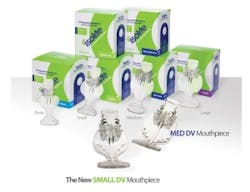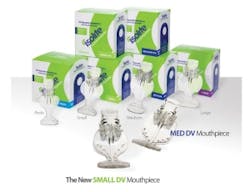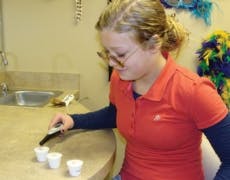Fatten up your patient base and skinny up your kids!
By Susan Maples, DDS, MSBA
Michigan, the state where I practice dentistry, is the poster child for the economic challenges facing our country. Our state also ranks eighth in the listing of U.S. states for fattest people, according to the Centers for Disease Control and Prevention.
Combine these two factors, and it’s clear that there’s an opportunity to educate children about sound nutrition before the onset of costly medical problems spurred by obesity.
Through a radical paradigm shift in our practice’s approach to children’s health, we boosted team morale, inspired an influx of new patients, and began making a contribution to children’s oral and nutritional health. We designed and implemented a SCIENCE Hands-On Learning Lab™ that begins with a self-prophy model and includes more than 40 science experiments. We quickly became the talk of our community — in a positive way. You can do this, too!
Oral and aural issues
Our goal for children has remained clear: to help kids graduate from high school with skills and behaviors for a lifetime of dental health. During the last decade, we have witnessed more kids missing the mark, with increased decay and reduced plaque control. But something else was disturbing.
Along with rising consumption of sugar-laden beverages and junk food came a decrease in physical activity and a marked increase in body fat storage. I wanted to address obesity with my patients also — just like 51% of you do, according to a recent JADA cover article (Curran et al., Nov 2011).
But few dentists are ready for this. Why? The reasons cited for not addressing obesity include lack of sensitivity training, expertise, and effective tools. Dental caries and obesity are clearly the two greatest health risks for kids, and both conditions are 100% preventable. Nutrition problems are not just a dental issue, but a public health issue that will fall upon an already crippled health-care system. So who is listening?
For our young patients, unfortunately — and herein lies another challenge — we “talk” our message, but our words often fall on deaf ears. Generation Z is socially distracted beyond measure, preoccupied by whatever “app” was last loaded.
Perhaps none of our brains are wired for teach-and-tell learning. But these kids are especially tuned out to the drone of an authoritarian teacher. Looking for a breakthrough, we decided to put learning into their hands.
From rubber cup to self-prophy
Following the Chinese proverb, “Give a man a fish and you feed him for a day. Teach a man to fish and you feed him for a lifetime,” we radically changed the way we clean teeth.
In a lighted, magnified mirror mounted over a small sink in our Learning Lab, we now mentor each child through a complete plaque removal. After disclosing, he or she chooses what tool to try first, second, and so on, from a vast array of de-plaqueing items commonly available in drug stores.
Without providing any instruction initially, we observe the patient’s present skills and offer tips to boost effectiveness. Our tracking record aims at individual skill development, and recording what the child chose, stated as goals, viewed as obstacles, and more.
Our role is to facilitate behavioral changes that impact health. While it was easy to change the physical structure of the prophy, it was much more difficult to change the way we conducted ourselves. Here we put each child in the driver’s seat of his or her learning process, allowing the child to be curious about what is possible.
Science experiments
Following the self-prophy, each child engages in one or two simple hands-on science experiments selectedI get a kick out of hearing a child ask a parent to switch from hydrogenated peanut butter to natural peanut butter!
Each exercise is reflected as a complimentary value-added service on the family ledger, and the child often leaves with a keepsake. These reminders cement the learning, and act as powerful means of internal marketing.
Nutrition advocacy
Several of the experiments are nutrition-related, focusing on food quality and quantity. Measuring the sugar in their favorite beverages and breakfast cereals is just the beginning. Portion sizes, quality fats, and fast-food analysis are critical, too.
Again, hands-on experiments create indelible lessons that kids will use to educate their parents. Circumventing parents in the initial learning provides many advantages, especially for the adolescent who is seeking ways to gain independence and respect. Many children are more adaptable to change than their parents, and less likely to be stuck in a routine.
Addressing obesity can be easy with the right mindset and effective tools. Children don’t want to be lethargic or fat, and they may tell you that directly. Using nonjudgmental, open-ended questions, we invite children to tell us about their current eating habits and what they have noticed (positive or negative) as a result of the foods they choose.
Hearing from children about their desires to be strong and healthy and avoid getting fat — before we offer any teaching — gets them in the right frame of mind. Listening generously will ready a child to make significant personal substitutions, one food choice at a time.
We use the On Target Living™ food target, which displays a range of poor- to excellent-quality foods in each sector (carbohydrate, fat, and protein). Any child who can read is able to engage in this exploration. I get a kick out of hearing a child ask a parent to switch from hydrogenated peanut butter to natural peanut butter!
Exposure to dental careers
Many of these experiments give kids a unique exposure to clinical practice. Children who are not cavity-prone receive little or no exposure to restorative, reconstructive, or cosmetic dentistry.
Those who are cavity-prone witness dentistry only from their personal perspective, perhaps as an anxious patient. By participating in hands-on diagnostic and restorative experiences, we can pique a child’s interest in dental careers. Examples include using a DIAGNOdent and explorer on extracted teeth, placing a sealant, completing a forensics mystery, and disengaging an implant restoration from a model.
Marketing advantages
“Aha” learning is exciting. Parents love to see their kids pumped up about new realizations. Consequently, the word-of-mouth buzz from our patients to their friends has been incredible. Plus these experiments can be set up easily in a classroom setting.
Imagine a couple of your team members facilitating a middle school class on nutrition and caries prevention. Sending a letter home to parents with a brochure about your hands-on dental program can be another “Aha” moment — this time for Mom or Dad.
The upshot for your practice
Changing how you treat and teach young patients can put your practice on the map with a big splash. You can be recognized as a cutting-edge practice — one that truly cares about the well being of kids. While we contribute to the vigor of future adults, we’ll accept a pat on the back for decreasing the burden on our health-care system.
Personally, we have found few endeavors as revitalizing as learning and practicing facilitation. Lecturing patients is a teaching model that depletes our creativity and energy.
Conversely, being in the presence of a patient who chooses health and agrees to change behavior to support it helps reverse burnout and reinforces our decision to become part of a health-care team.
Final Note
Change is difficult. But if you dislike change, you will like obsolescence even less. So jump into the fight on two 100% preventable health threats — obesity and dental disease. Rejuvenate your team with a new approach to treatment, change the lives of the young people you see, and watch how you become the new patient magnet in your community!
Dr. Susan Maples has a private practice in Holt, Mich. In addition, she is a business consultant in strategic target marketing. She is the originator and author of the Hands-On Learning Lab Kit. For more information, contact Dr. Maples through www.DrSusanMaples.com or www.HandsOnLearningLab.com.
Past DE Issues


